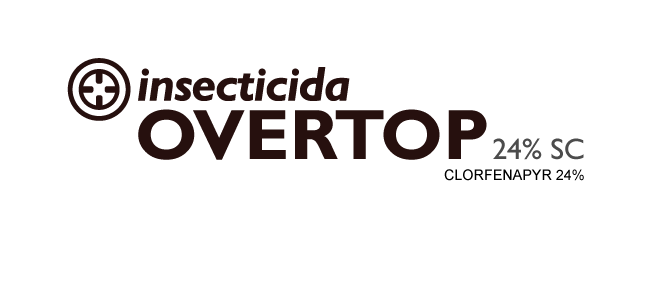
Composition:
| Clorfenapyr: 4-bromo-2-(4-chlorophenyl)-1-ethoxymethyl-5-trifluoromethyl-1Hpyrrole- 3-carbonitrile | 24 % (p/v) |
| Inert | 76 % (p/v) |
Chemical group:
PYRAZOL.
Formulation:
CONCENTRATED SUSPENSION (SC).
Overview:
OVERTOP 24% SC it is an acaricidal insecticide that acts by ingestion and contact. It does not affect the beneficial fauna of mites and insects, therefore is recommended for the integrated plagues management programmes.
Application method:
The application can be via air or land.
- Add water to the sprayer tank up to half its capacity.
- Start the stirring system.
- Add the necessary amount of the formulation, according to the calibration carried out, directly into the tank and without prior dissolution.
- Check the correct dilution of the product.
- Fill the tank with water up to the final volume.
- Check that the agitation system works at all times.
- Use the product within 24 hours after the carrying out the mixture in the tank.
- Re-agitate the liquid before resuming the application.
- Always use clean water.
Phytotoxicity and compatibility:
Avoid mixing it with alkaline products. Before using the mixture with other products conduct a small-scale test to evaluate the physical and biological compatibility of the components and the possible phytotoxicity for the crops.
Re-entry time to the area of treatment:
1 day. If the re-entry is necessary before term, do it employing personal protective equipment.
Toxicological class:
Class III – Blue stripe.
Antidote:
Does not possess.
Packing:
1- Boxes of 4 containers of 5 Lts.
Directions for use:
Diseases:
– Broad Mite / Polyphagotarsonemus latus
– Red Spider Mite / Tetranychus urticae
– Cotton leafworm / Alabama argillacea
– Tobacco budworm / Heliothis virescens
Dose (ml/ha): – Broad Mite: 1000 – 1200
– Red Spider Mite: 1000
– Cotton leafworm: 800 – 1200
– Tobacco budworm: 1000 – 1500
Time of Application:
– Broad Mite and Red Spider Mite: when they reach the economic damage level.
– Cotton leafworm: apply when 15-20 larvae per row meter are observed, preferably until L3 (larvae of 1,5 – 2cm).
– Tobacco budworm: with 15% of knobs attacked. Repeat as needed.
WP (days): 21
MRL (mg/kg): n/e
Diseases:
– Fall armyworm / Spodoptera frugiperda
Dose (ml/ha): 750 – 1000
Time of Application: When the first infestation outbreaks are observed.
WP (days): n/e
MRL (mg/kg): n/e
Diseases:
– Fall armyworm / Spodoptera frugiperda
Dose (ml/ha): 500 – 750
Time of Application: At the beginning of the plague emergence, with 20% of larvae presence on the plants.
WP (days): 45
MRL (mg/kg): n/e
Diseases:
– Whitefly / Bemisia tabaci
– Melon Thrips / Thrips palmi
– Cucurbit beetle / Diabrotica speciosa
Dose (ml/ha): – Whitefly: 1000
– Melon Thrips and Cucurbit beetle: 500 – 750
Time of Application: At the beginning of infestation.
WP (days): 14
MRL (mg/kg): n/e
Diseases:
– Cotton bollworm / Heliothis virescens / Helicoverpa armigera
– Velvetbean caterpillar / Anticarsia gemmatalis
– Soybean Looper / Chrysodeixis includens
– Armyworm / Spodoptera spp.
– Red Spider Mite / Tetranychus urticae
Dose (ml/ha): – Cotton bollworm: 800 – 1200
– Velvetbean caterpillar: 750
– Soybean Looper: 600 – 1200
– Armyworm and Red Spider Mite: 750 – 1000
Time of Application: – – Cotton bollworm, Velvetbean caterpillar, Soybean Looper and Armyworm: when the first infestation outbreaks are observed. Note: use the highest dose when the caterpillars are larger than 2 cm.
– Red Spider Mite: when it reaches the economic damage level.
WP (days): 14
MRL (mg/kg): n/e
Diseases:
– Moth / Tuta absoluta
Dose (ml/ha): 50 cm3⁄100lt of water
Time of Application: Start applications before the emergence of the plague. It should not exceed 5 applications during the entire crop cycle.
WP (days): 7
MRL (mg/kg): n/e
WP: Waiting Period
MRL: Maximum Residue Limit
n/e: not established
Downloads
239 KB


